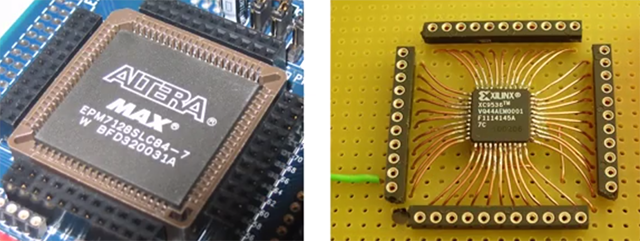
Over on the University of Reddit there’s a course for learning all about FPGAs and CPLDs. It’s just an introduction to digital logic, but with a teacher capable of building a CPLD motor control board and a video card out of logic chips, you’re bound to learn something.
The development board being used for this online course is an Altera EMP3032 CPLD conveniently included in the Introduction to FPGA and CPLD kit used in this course. It’s not a powerful device by any measure; it only has 32 macrocells and about 600 usable gates. You won’t be designing CPUs with this thing, but you will be able to grasp the concept of designing logic with code.
Future lessons include building binary counters, PWM-controlled LEDs, and a handheld LED POV device. In any event, it’s a great way to learn about how programmable logic actually works, and a fairly cheap way to get into the world of FPGAs and CPLDs. Introductory video below.














Wow, that SMT on perfboard shows up on occasion, that’s some crazy delicate looking soldering. That’s a situation where I’d find or make an SMT to breadboard adapter PCB.
Check out http://elm-chan.org/docs/wire/wiring_e.html and the other projects there if you want to see insane SMT on perfboard wiring.
definately into this
Why do you call this a ureddit class when this is just a link to the ongoing PyroElectro series?
If HaD has not done a dedicated feature on PyroEdu, they really should… (hint hint)
I hope Altera’s tools are better than Xlinx ISE. Xlinx ISE is a downright broken tool that doesn’t run on modern machines, doesn’t support older devices (even though they are still being sold) and can only be downloaded in one large package that contains over 10GB of crap that you will never use.
If you haven’t already done so, you could also consider Lattice devices/tools as well – their chips are quite good. Furthermore, their Diamond software is quite easy to use and ‘only’ a 1.5GB download :-)
Don’t set your hopes too high… :)
Xilinx ISE runs just fine on a “Sandy Bridge E” Core i7. I’d be surprised if it doesn’t work on Ivy Bridge (E) or Haswell.
Altera Quartus is quite a bit better IMO. That said, all EDA tools are crap, just some worse than others. ISE is definitely horrid.
For these EPM3064 and such MAX3000A series CPLDs, you will need to use Quartus 13.0sp1, not the most recent version. Altera has finally dropped support for these devices after 13 years. The MAX3000 cplds are the last real TRUE cplds. The Max II and Max V are basically sram fpgas but thye configure themselves from onboard eeprom at powerup very quickly.
>it only has 32 macrocells and about 600 usable gates. You won’t be designing CPUs with this thing,
I beg to differ:
https://github.com/cpldcpu/MCPU
Wow! well done Sir.
yes, you could make a very ismple CPU on these. I made a cpu out of five 22V10’s once. it was a tight fit but did work.
/highfive Great job. Have you thought of how to expand the microcode to implement other commands?
It’s fairly easy to add more commands, when expanding the CPU to 16 bit. Several other people have done so in the past – this is an old design.
If anyone is interested, I did come up with an idea for making SMD “protoboard” adaptors, essentially they are the same as syringe needles but with hollow copper in place of steel. Its possible to deform copper wire using electrolysis from a sewing needle point, and then the wire sits in the hole thus formed.
With the advent of services like OSHpark and existence of surfboards/schmartboards the photo looks a bit crazy. Especially given time involved in getting that soldering job done well.